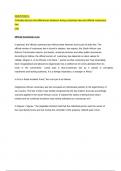QUESTION 1
Critically discuss the differences between living customary law and official customary
law.
[30]
Official Customary Law
In general, the official customary law reflects state interests and is part of state law. The
official version of customary law is found in statutes, law reports, the South African Law
Reform Commission reports, text books, university lectures and other public documents.
According to Ndima, the official version of customary law depends on alien values for
validity. Mogoro J, in Du Plessis v De Klerk 1, points out that customary law "has lamentably
been marginalised and allowed to degenerate into a vitrified set of norms alienated from its
roots in the community". Costa puts it thus:Customary law as it stands is corrupted,
inauthentic and lacking authority. It is a foreign imposition, a stranger in Africa.2
In Fosi v Road Accident Fund,3 the court put it as follows:
Indigenous African customary law has occupied an unfortunate position in the legal history of
our country. The fact is that it was hardly recognized by the law-makers and was accordingly
scarcely applied in the South African courts. It enjoyed the status of being known that it
existed and its continued existence was merely tolerated as a necessary evil.
In Sigcau v Sigcau, 4 the Appellate Division held that the individual person was the owner of
the royal family home and not merely the controller of the property. Ndima5 puts it thus:
️
,However, the learned Chief Justice refused to vacate his common law comfort zone,
although he was dealing with an African customary law problem. He continued to use the
same institution, which his experience of common law made him use, to describe the rights
of the defendant, in an African matter. By doing this he unwittingly committed an unforgivable
comparative law mistake, namely, looking at foreign law (African customary law) with the
eyes of his own system (common law).
Living Customary Law
6
Living customary law is the "law actually observed by African communities".
It is the
unwritten law that is passed on from generation to generation and is part of the culture and
tradition of the community. 7 It evolves as the circumstances of society change. 8
However, a
change of legislation, in particular, and written law, in general, often if not always requires
legislative intervention. Ndima9 puts it as follows:
When it comes to the pervasive problem of developing African customary law, the judiciary
faces the additional challenge of determining the living version of customary law for the
community concerned. One of the injustices of the past, which our constitutional interpreters
must reject in striving to heal our historical divisions, is the distortion caused to African law
by the application of the interpretive technique of repugnancy. This method removed the
philosophical underpinnings (which the colonial officials perceived to be in conflict with
Western morality) from African customary law.
The development of the law is not only a catholic but is also an age-old world- wide
phenomenon. For instance, according to Hahlo,10 western European marriage law developed
in three stages. During the first stage, marriage was a private matter between spouses and
their families. During the second stage, marriage was under the jurisdiction of the church.
During the last stage, marriage passed under the control of the state. The court, in Rolfes,
Nebel and Co v Zweigenhaft,11 said:
, This court would be loath to upset a [contemporary] practice that had become a general
custom of South Africa, even if it were somewhat different from the Roman-Dutch [legal]
practice.
12
In the case under discussion, a principle of Roman-Dutch law in question had fallen into
disuse and an indigenous "customary" legal principle had come into effect. The court
accepted that the law had developed and that the established contemporary legal custom
overrode the Roman-Dutch legal practice which had fallen into disuse. The legal
development was not legislated but had evolved in response to the changing circumstances
of society. In Henderson v Hanekom,13 Sir Henry de Villiers CJ put it thus: There must, in the
ordinary course, be progressive development of the law keeping pace with modern
requirements.
In MM v MN and Another,14 the Constitutional Court said:
Paradoxically, the strength of customary law – its adaptive inherent flexibility – is also
potentially difficult when it comes to its application and enforcement in a court of law.15
The Constitution imposes a duty upon a competent court to develop customary law
consistent with its provisions. 16 "It follows implicitly that, wherever common law or customary
law deviates from the spirit, purport and objects of the Bill of Rights the courts have an
obligation to develop it by removing the deviation."17 In other words, the courts in carrying out
their section 39(2) developmental function must have regard to the spirit, purport and
objects of the Bill of Rights. Section 39(2) provides:18
When interpreting any legislation, and when developing the common law or customary law,
every court, tribunal or forum must promote the spirit, purport and objects of the Bill of
Rights.
Customary law, essentially the customs of indigenous communities, is also subject to
change and may be developed by the court and the legislature. In a minority judgment
12 Rolfes, Nebel and Co v Zweigenhaft 1903 TS 185 206.
13 Henderson v Hanekom 1903 20 SC 513 519. Hereafter the Henderson case.
14 MM v MN and Another 2013 4 SA 415 (CC) para 25.
15 S 39(2) of the Constitution.
16 S 39(2) of the Constitution.
17 Carmichele v Minister of Safety and Security 2001 10 BCLR 995 (CC).
18 S 39(2) of the Constitution.




